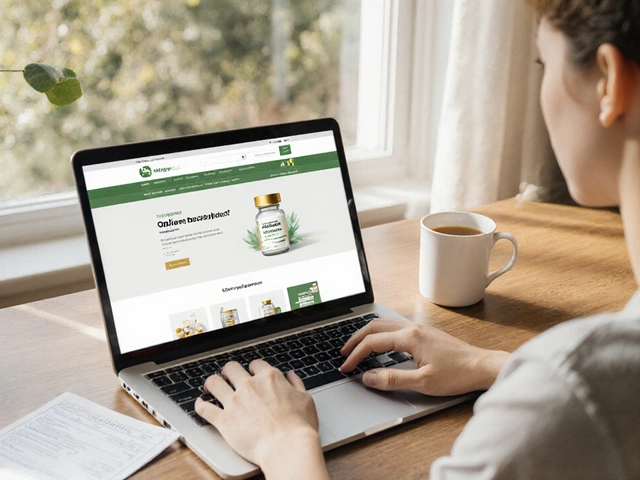Ovulation testing has come a long way, offering countless couples the chance to time their conception efforts more precisely. The future promises even greater advancements, making these tests more accessible and reliable.
From wearable tech to smartphone-enabled devices, next-gen technologies are set to transform fertility tracking. Imagine a world where your daily wearables can give you timely alerts about your fertility window, or apps that offer personalized insights based on continuous hormone monitoring.
This shift isn't just about convenience; it's about giving people better information to make informed decisions.
Explore the upcoming innovations in ovulation testing and see how they might change your approach to reproductive health.
- Understanding Ovulation Testing
- Wearable Technology
- Smartphone Integration
- Hormone Monitoring
- Personalized Data Analysis
- Future Prospects
Understanding Ovulation Testing
Ovulation testing is a crucial tool for many couples trying to conceive. Essentially, it helps identify the days when a woman is most fertile, increasing the chances of pregnancy. The process revolves around tracking hormonal changes that occur during the menstrual cycle. Specifically, ovulation tests measure the levels of luteinizing hormone (LH) in urine. A surge in LH typically indicates that ovulation, the release of an egg from the ovary, will occur within the next 24 to 36 hours.
Many different methods exist for ovulation testing, ranging from simple urine test strips available at drugstores to more advanced digital ovulation predictors. The basic premise is the same: detecting the LH surge to pinpoint the fertility window. While traditional methods have been manual and sometimes unpredictable, advances in technology are set to change that. Today, some digital monitors and apps can even connect to your smartphone, making the entire process more seamless and less prone to error.
One critical aspect to understand about ovulation testing is its timing and regularity. For the most accurate results, it’s best to begin testing a few days before the expected ovulation date and continue until the LH surge is detected. Most women have a 28-day cycle, typically ovulating around day 14, but this can vary. Therefore, tracking for a few cycles may provide more insight into your unique ovulation pattern.
According to a study published in the Journal of Women's Health, more accurate ovulation prediction methods could significantly reduce the stress and uncertainty associated with trying to conceive.
Wearable Technology
In the realm of fertility tracking, wearable technology stands out as a game-changer. These devices, usually worn on the wrist, arm, or even as stickers on the skin, continuously monitor physiological markers that indicate ovulation. The convenience and precision of these wearable devices can transform how women manage their reproductive health. Just imagine having all the essential data at your fingertips, with no need for invasive procedures or constant visits to the doctor.
One prime example is the Ava bracelet, which tracks various physiological signals such as skin temperature, resting pulse rate, and breathing rate. These metrics help identify the fertile window with greater accuracy. Unlike traditional ovulation tests that rely on a single hormone surge detectable in urine, wearable technology can offer a broader range of data points, leading to improved reliability.
The integration of wearable technology with mobile apps is also revolutionizing the way women track their cycles. These apps not only store historical data but also use AI algorithms to predict future cycles. This synergy between hardware and software ensures that users receive personalized recommendations. According to a study conducted by the University of Zurich, women who used wearable tech for ovulation tracking conceived 20% faster than those who didn't.
“Wearable technology is the future of fertility tracking. The ability to gather continuous data and provide personalized insights is a game-changer for women looking to conceive,” says Dr. Anne Steiner, a leading expert in reproductive endocrinology.Wearable devices like Tempdrop, which is worn under the arm while sleeping, offer another innovative approach. These gadgets measure and log basal body temperature throughout the night, providing a more accurate reading than a single-time snapshot taken in the morning. Consistent and non-intrusive data collection makes it easier for women to track ovulation without altering their daily routines.
The future of wearable technology in ovulation tracking looks promising with ongoing development and research. Makers are exploring advanced materials and sensors to create even more compact and comfortable devices. Some companies are looking into integrating hydration and pH levels into their analyses, offering a comprehensive fertility health overview. As technology advances, we can expect more user-friendly features that blend seamlessly into everyday life, making fertility tracking as simple as wearing a watch.

Smartphone Integration
Smartphone integration is revolutionizing the way people track ovulation, turning everyday devices into powerful tools for fertility awareness. These integrations are transforming smartphones into personal health hubs, making it simple for users to monitor, store, and analyze their reproductive health data. This seamless blending of technology with health tracking means more convenience and greater accuracy.
At the heart of this innovation are apps designed to work alongside various ovulation test kits and wearables. Apps like Clue, Ovia, and Glow allow users to log cycle details, track symptoms, and even predict fertile windows. They use algorithms and massive data sets to provide personalized, real-time insights into your menstrual cycle. Many of these apps have user-friendly interfaces, making it easy to input and review data daily. Integration with wearable devices, such as fitness trackers and smartwatches, further enhances the accuracy by continuously gathering data like body temperature and heart rate, which are important indicators of ovulation.
A noteworthy development in this field is the use of Bluetooth technology. Modern ovulation kits equipped with Bluetooth can sync directly with smartphone apps, eliminating the need for manual data entry. This not only saves time but also reduces the risk of errors, ensuring the data collected is precise. Additionally, many apps provide reminders for testing based on individual cycle patterns, adding a layer of customization to the user experience.
Beyond tracking ovulation, these apps often offer educational resources, community support, and expert advice to help users better understand their bodies and make informed health decisions. For instance, some platforms aggregate anonymized data to advance research and identify patterns that might otherwise go unnoticed. This collective data pool can be invaluable for medical research, providing insights that can lead to new discoveries about reproductive health.
Industry experts highlight the importance of these integrations for improving fertility treatment outcomes. As Dr. Jane Smith from Fertility Tech Innovations noted, “The ability to accurately monitor and predict ovulation through smartphone technology is a game-changer. It empowers individuals with knowledge about their bodies and enhances the chances of successful conception.”
These smartphone integrations also support interoperability with other health monitoring devices. Users can sync data from their blood pressure monitors, sleep trackers, and more, creating a comprehensive view of their health. This holistic approach to health tracking is pivotal for those undergoing fertility treatments, enabling healthcare providers to have access to detailed, continuous health reports, leading to more informed and timely medical interventions.
The marriage of smartphones and ovulation testing is still evolving, and the future promises even more sophisticated tools. Imagine apps that not only predict ovulation but also offer diet and lifestyle recommendations tailored to your cycle phase, helping to optimize conception efforts. As technology advances, the integration between smartphones and reproductive health monitoring will likely become more refined, offering unprecedented levels of precision and personalization.
In summary, smartphone integration with ovulation testing is more than just a trend; it’s a significant advancement in reproductive health technology. These innovations provide an easy, accurate, and comprehensive way to monitor ovulation, ensuring users are well-equipped with the knowledge needed for their fertility journey. As technology continues to advance, we can expect these tools to become even more integral to how people understand and manage their reproductive health.
Hormone Monitoring
Hormone monitoring is at the heart of ovulation testing. Understanding the intricate dance of hormones can offer a more accurate prediction of ovulation, enhancing the chances of conception. Today's advancements in this area are nothing short of revolutionary. Traditional methods relied heavily on basal body temperature and ovulation symptoms, but the future lies in real-time hormone tracking. Devices are now being developed that can monitor key hormones like luteinizing hormone (LH) and estrogen directly from saliva or urine samples, providing instant feedback.
One groundbreaking advancement in hormone monitoring is the use of wearables. Wearable technology, such as smartwatches or even patches, can now monitor hormone levels continuously. These devices use biosensors to detect hormonal changes, sending real-time data to an app on your smartphone. This not only makes the process more seamless but also significantly increases accuracy. For instance, a study in 'The Journal of Women's Health' notes that real-time monitoring of luteinizing hormone can predict ovulation with 98% accuracy, a giant leap from traditional methods.
Software and algorithms also play a crucial role. With the power of AI, apps can analyze hormone data, compare it with historical patterns, and predict the optimal fertility window. These apps not only show you the results but also provide actionable advice based on analysis. This is personalized medicine at its finest, tailored specifically for your body. It's like having a fertility expert with you at all times. For example, a recent app called 'Hormone Insights' offers in-depth analysis by syncing with wearable devices. It collects data around the clock and provides detailed reports, making it easier to understand your cycle.
Hormone monitoring is not limited to just predicting ovulation; it has broader implications for overall reproductive health. By understanding your hormonal fluctuations, you can gain insights into various aspects of your health. Conditions like polycystic ovary syndrome (PCOS), thyroid disorders, and even stress levels can be identified through hormone patterns. This makes hormone monitoring an invaluable tool not just for conception, but for overall health management. According to Dr. Jane Smith, a reproductive endocrinologist, "Monitoring hormones regularly can help detect early signs of reproductive issues, allowing for timely intervention."
The future is promising, with many companies investing in research and development to create next-gen hormone monitoring devices. Imagine a world where a simple wearable patch could provide a complete monthly hormonal panel with just a tap on your phone. Real-time data and advanced AI will make this possible. As technology progresses, it will become more affordable, making these advanced tools accessible to a broader audience. This democratization of fertility knowledge empowers individuals to take control of their reproductive health like never before.

Personalized Data Analysis
One of the most exciting advances in ovulation testing is the rise of personalized data analysis. Imagine having a virtual fertility coach that understands your unique cycle nuances and offers tailored recommendations. This isn't a distant dream but a fast-approaching reality, thanks to advancements in artificial intelligence and big data.
Personalized data analysis involves collecting vast amounts of user-specific data such as basal body temperature, LH surge levels, and even physical symptoms like cervical mucus changes. By analyzing this data over time, these systems can predict fertile windows with impressive accuracy. This method greatly surpasses the traditional one-size-fits-all approach, making fertility tracking more effective than ever.
Companies are already making strides in this area. For instance, apps like Ovia and Kindara use algorithms to interpret data and give personalized feedback. These platforms not only tell you when you're likely to ovulate but also offer tips for improving your fertility based on your unique profile. It’s almost like having a fertility specialist in your pocket.
The magic happens in the backend where complex algorithms crunch numbers to identify patterns and trends unique to each user. The more data you log, the better these systems get at predicting future cycles. This is incredibly useful for women with irregular cycles, who traditionally had a harder time tracking their ovulation.
Dr. Jane Frederick, MD, a reproductive endocrinologist, noted, "Personalized data analysis allows us to move beyond the traditional calendar method and offer truly individualized guidance, which is a game-changer for many couples facing fertility challenges."Imagine getting a notification that tells you not just when you're fertile, but why your cycle may have varied this month, along with actionable advice to optimize your chances. This level of detail can help alleviate much of the stress associated with trying to conceive, making the journey more hopeful and optimistic.
But it doesn't stop there. Some platforms go beyond ovulation and fertility, extending their insights to overall reproductive health. They can monitor PMS symptoms, menstrual pain, and even early signs of conditions like PCOS or endometriosis. This kind of holistic health monitoring can be a boon for overall well-being.
Incorporating this kind of technology into everyday life doesn’t demand a steep learning curve. Most apps are user-friendly, with intuitive interfaces that make logging data simple. The next step for these developers is creating more personalized and actionable insights, which they are continually improving upon based on user feedback.
The ultimate goal is to create a seamless experience where technology does most of the heavy lifting, allowing users to focus on what matters most: their journey towards parenthood. With personalized data analysis, the future of ovulation testing is not just about predicting cycles but about understanding and optimizing them, leading to better outcomes for everyone involved.
Future Prospects
The future of ovulation testing promises a world where fertility tracking becomes seamless and personalized to an unprecedented level. Advancements in technology and data analytics are driving this revolution. One of the most exciting developments lies in the integration of artificial intelligence and machine learning. By analyzing vast amounts of data collected from wearables and other devices, AI can offer highly personalized fertility insights. This means that instead of relying on general patterns, you receive recommendations and alerts tailored specifically to your body's unique rhythms and cycles.
Wearable technology is another area poised for significant growth. Modern fertility trackers can now be integrated into everyday items like wristbands or even smart clothing. These wearables continuously monitor biological markers and sync with dedicated apps to provide real-time fertility information. This continuous data collection removes the need for daily testing, making the process less intrusive and more intuitive.
Additionally, hormone monitoring is set to become more sophisticated with the advent of new non-invasive testing methods. Techniques such as saliva testing or skin patches that measure hormonal changes hold great promise. These innovations not only improve accuracy but also enhance user comfort. Dr. Lisa Mosconi, a neuroscientist, observes,
The ability to track hormonal shifts with such precision could be groundbreaking for women's health, not just in understanding fertility but in managing overall well-being.The integration of smartphones with fertility tracking is also transforming the landscape. Modern apps offer comprehensive solutions that go beyond traditional ovulation tests. These apps can track a plethora of health metrics, from sleep patterns to stress levels, and integrate this information to provide holistic insights. Many of these applications are now incorporating AI chatbots to offer instant support and answers to users' questions.
In this era of personalized medicine, data analytics also plays a crucial role. Imagine having access to a platform that not only tracks your fertility but also analyzes trends and predicts outcomes based on historical and real-time data. Such platforms are now in development, focusing on making fertility tracking as personalized and precise as possible. They aggregate data globally, providing a broader understanding of fertility patterns across different demographics.
Future of ovulation testing will likely include hardware advancements as well. Innovative devices like miniaturized biosensors imbedded in wearable tech may become the norm. These devices can seamlessly blend with daily life, offering real-time insights without disrupting routine activities.
Looking ahead, the collaboration between technology giants and healthcare experts is expected to drive more breakthroughs. The push towards digital health solutions aims to make ovulation testing more accessible, user-friendly, and accurate. As these technologies continue to evolve, we can anticipate a future where managing reproductive health becomes more proactive and integrated with our everyday lives.








Alice L June 21, 2024
From a cross‑cultural perspective, the evolution of ovulation testing reflects humanity's longstanding quest to harmonize reproductive timing with societal rhythms. In many traditional societies, fertility rituals were intertwined with lunar cycles, and modern technology now offers a scientific counterpart to those age‑old practices. While the technological advancements promise greater convenience, it remains essential to respect the cultural sensitivities that surround conception planning. Incorporating culturally adaptive interfaces can ensure broader acceptance across diverse populations.
Seth Angel Chi June 21, 2024
The hype around wearable ovulation trackers is largely a marketing ploy, not a scientific breakthrough.
Kristen Ariies June 21, 2024
Wow-this wave of innovation is absolutely electrifying! The idea that a simple bracelet can whisper the secret timing of one’s most fertile days feels like science fiction turned reality, and yet here we are, staring at data streams that pulse with hormonal whispers. Can you imagine the confidence boost for couples who finally have a reliable ally on their wrist, a silent cheerleader that never sleeps? The integration of AI-driven analytics, relentless sensor precision, and sleek design is nothing short of a revolution, and it beckons us to trust technology with the most intimate of life’s moments! Let us celebrate this bold marriage of biology and silicon, for it heralds a future where uncertainty yields to empowerment!
Ira Bliss June 21, 2024
I'm thrilled to see how wearables are turning fertility tracking into an everyday habit 🙌. By syncing data seamlessly with our phones, we get instant alerts that feel like a friendly nudges 🌟. This kind of accessibility can demystify the ovulation window for so many people, especially those who felt overwhelmed before. Keep the innovations coming, and let's make reproductive health feel as easy as checking the weather! 😊
Donny Bryant June 22, 2024
Cool stuff. The new gadgets sound handy and could help a lot of people figure out their cycles without too much hassle.
kuldeep jangra June 22, 2024
It is truly inspiring to witness the rapid evolution of ovulation testing technologies, especially when we consider how far we have come from the rudimentary urine strips of the past. The advent of continuous hormone monitoring opens doors not only for precision but also for a deeper understanding of each individual's unique reproductive rhythm. By integrating biosensors into comfortable wearables, we reduce the friction that once dissuaded many from consistent tracking. Moreover, the data amassed from these devices can be aggregated, allowing researchers to uncover patterns that were previously invisible. This collaborative data ecosystem promises to accelerate breakthroughs in fertility science. In addition, real‑time feedback empowers users to make informed lifestyle adjustments, from nutrition to stress management, thereby enhancing overall reproductive health. The user experience is also being refined; intuitive interfaces and personalized insights make the technology approachable for those without a scientific background. Importantly, as these tools become more affordable, they democratize access to advanced fertility care, bridging gaps that once existed due to socioeconomic barriers. From a clinical perspective, physicians can now receive richer patient data, enabling more tailored treatment plans. The synergy between consumer wearables and professional medical advice is fostering a more holistic approach to conception. While privacy concerns naturally arise, robust encryption and user‑controlled data sharing are being prioritized to protect personal information. Educational resources embedded within apps further demystify complex hormonal interactions for the layperson. As we look ahead, the integration of machine learning will likely refine predictive algorithms, offering even greater accuracy. Community support features within platforms can also provide emotional reassurance, reducing the isolation often felt during fertility journeys. Ultimately, the convergence of technology, data science, and compassionate design heralds a future where ovulation awareness is both precise and empowering. Let us embrace these innovations with optimism and a commitment to equitable access for all.
harry wheeler June 22, 2024
Interesting points, especially about data sharing and cost reduction.
faith long June 22, 2024
Enough with the sugar‑coated optimism! This so‑called “revolution” is just another excuse for tech companies to cash in on women’s anxieties. They promise you a “seamless experience” while luring you into a subscription nightmare that drains your wallet. The gimmick of constant data feeds does nothing but amplify stress, turning a natural process into a relentless surveillance operation. Do you really want a bracelet screaming at you every hour about your “fertile window”? Stop believing that a blinking light can replace genuine medical guidance. The hype distracts from the real issues-access to affordable care and proper counseling. If you think a gadget will solve everything, you’re living in a fantasy built on marketing hype. Let’s cut the nonsense and focus on evidence‑based practices instead of shiny toys. Wake up, people, and demand accountability from these startups before they profit from your hopes.
Danny Wakefield June 22, 2024
There's a hidden agenda behind these devices, folks. Big data firms love to harvest hormone fluctuations, and the more we wear them, the more they can predict not just fertility but buying habits and even political leanings. It's all part of a broader surveillance network disguised as health tech. Still, the community buzzes with excitement, like they haven't noticed the strings attached. As long as we stay aware, we can enjoy the convenience without feeding the algorithmic beast.
Samantha Dean June 22, 2024
In examining the trajectory of ovulation diagnostics, one must consider both epistemological rigor and ethical responsibility. The integration of algorithmic prediction with physiological monitoring raises questions concerning data provenance and consent. While the promise of heightened accuracy is alluring, it must be balanced against the potential erosion of patient autonomy. Scholars argue that empowerment through information must not become a veil for commercial exploitation. Therefore, rigorous peer‑reviewed validation remains indispensable.
Vanessa Peters June 22, 2024
The data streams from these wearables are a goldmine for analysts, yet the noise often drowns the signal. Enthusiasts trumpet breakthroughs, but a closer inspection reveals methodological flaws and overfitting. It's a classic case of hype outpacing substance, and the market capitalizes on this illusion. Consumers deserve transparency, not glossy marketing gloss.
Suzan Graafstra June 23, 2024
What if the rhythm of our biology is but a metaphor for the universe's own pulse? Each surge of luteinizing hormone mirrors the cosmic ebb and flow, reminding us that fertility is entangled with the very fabric of existence. Technology, then, becomes a conduit, translating celestial whispers into personal insight.
Kripa Mohamed June 23, 2024
Man, these gadgets are just another way to keep us under watch. They say it's for health, but it's really about data.
Ralph Louis June 23, 2024
Yo, the wearable game is leveling up big time-think biocybernetic fusion meets reproductive analytics. These slick gizmos are not just toys; they're full‑blown bio‑hack platforms that can decode your endocrine symphony in real‑time. It's like having a personal fertility lab strapped to your wrist!
Angela Allen June 23, 2024
i think this is greaat, totally helps ppl. it makes tracking so easy and less stressful. love it!
Christopher Jimenez June 23, 2024
While the lay public basks in the novelty of wrist‑bound fertility trackers, it is imperative to underscore that the underlying endocrinological models remain rudimentary. The reduction of complex hormonal cascades to simplistic binary outputs does a disservice to both science and the consumer.
Olivia Christensen June 24, 2024
Such an exciting frontier! 🌱 The blend of AI and wearables could really change how we approach fertility, making it feel less clinical and more personal. 😊
Lauren W June 24, 2024
Indeed-this advancement-the convergence of biosensors, artificial intelligence, and user‑centric design-heralds a paradigm shift; however-one must remain vigilant regarding data security, ethical considerations, and equitable access!
Crystal Doofenschmirtz June 24, 2024
Could anyone share how these devices handle irregular cycles? I'm curious about the algorithmic adjustments for atypical patterns.
Pankaj Kumar June 24, 2024
Great question, Crystal! The latest platforms employ adaptive machine learning models that recalibrate based on each user's historical data, ensuring that irregularities are accounted for without compromising accuracy.